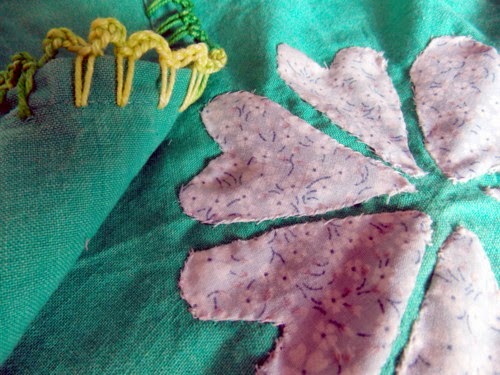HOW TO APPLIQUE
 Appliqué technique has a few different methods that can be used.
There is the traditional to the super quick method.
Appliqué technique has a few different methods that can be used.
There is the traditional to the super quick method.
TRADITIONAL APPLIQUE:
To begin lightly trace appliqué design onto background
fabric with a pencil. Trace each appliqué piece onto paper and cut out. Pin
each paper shape, face down onto the wrong side of the appropriate fabric, then
cut shapes from fabric, adding 7mm seam allowance. Clip curves and V’s.
Turn seam allowance over the edge of the paper and tack in
place through both layers. Pin or tack shapes in place on background fabric and
stitch in place with small hemming Stitches in matching thread, catching only
the folded edge of the shape. Stitch within 2cm of starting point, remove paper
with tweezers and finish stitching.
TRADITIONAL APPLIQUE TWO:
Trace appliqué design onto background fabric with a pencil.
 Trace each appliqué piece onto firm paper and cut out. Draw
around each shape on the right side of the fabric and remove pattern piece. Cut
out shapes from fabric, adding 7mm seam allowance. With fingers, turn under
seam allowance, following pencil line and tack in place as you go. Pin tacked
shapes to background and stitch in place around edges with small hemming
stitches, catching only the folded edge of the shape.
Trace each appliqué piece onto firm paper and cut out. Draw
around each shape on the right side of the fabric and remove pattern piece. Cut
out shapes from fabric, adding 7mm seam allowance. With fingers, turn under
seam allowance, following pencil line and tack in place as you go. Pin tacked
shapes to background and stitch in place around edges with small hemming
stitches, catching only the folded edge of the shape.
NO TURN APPLIQUE:
Cut all appliqué shapes, with a 7mm seam allowance, from
both coloured fabric and backing fabric, such as lawn or calico, taking care to
cut mirror pairs.
With right sides together, stitch shapes together around
edges, leaving a small opening for turning. Clip curves, turn right side out,
slip-stitch opening closed, and press. Stitch these shapes to background, using
small hemming stitches.
SUPER QUICK APPLIQUE:
Trace appliqué outlines onto double-sided iron on webbing.
Cut out roughly and fuse each shape to wrong side of appliqué fabric (This will
result in reversed image. If you want image to be the right way round, flip
outline before tracing.) Cut out accurately along traced lines.
Remove backing paper and press shapes onto backing fabric.
Edges can be left unstitched, but to make them more durable, they should be
finished with machine appliqué (a close, narrow zigzag), or with blanket stitch
by hand.
Useful links:
I hope everyone is having a good day or evening where ever you are.




Gosh Shiralee is there anything you can't do? I am very impressed (and envious!) . I am enjoying reading your posts and seeing all the clever things you do.
ReplyDeleteSherri,
Deleteperfection is something I can't do. Oh and knitting and making clothes and I'm rubbish at gardening and...well a lot more. It's just about trying and anyone can have a go at that. I hope you have a go too and not just read.
-Shiralee.
Some nice work there once again, Shiralee. You are a very clever vegemite.
ReplyDeleteNanna Chel,
DeleteThanks. Hope you are enjoying the rain.
-Shiralee.
So clever......yet again.
ReplyDeletePhil,
DeleteThanks.
-Shiralee